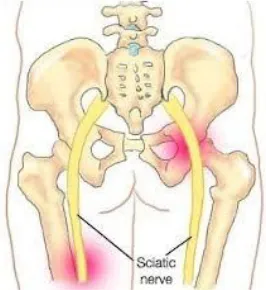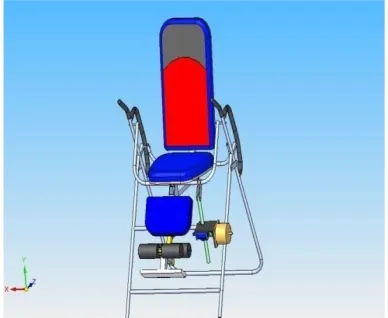Available Online at www.ijpret.com
420
INTERNATIONAL JOURNAL OF PURE AND
APPLIED RESEARCH IN ENGINEERING AND
TECHNOLOGY
A PATH FOR HORIZING YOUR INNOVATIVE WORK
DEVELOPMENT AND MODELLING OF AN APPARATUS FOR INVERSION THERAPY
AND ZERO GRAVITY CONCEPT FOR ALL BACK PAIN DISEASES
ABHIJEET A. RAUT, PROF. S. T. BAGDE
Department of Mechanical Engineering, Yeshwantrao Chavan College of Engineering, Hingna road, Nagpur
Accepted Date: 27/02/2014 ; Published Date: 01/05/2014
\
Abstract:From the moment we are born, and throughout our lifetime, we fight a constant
battle against a downward compressive force of nature the force known as gravity. Some negative effects of gravity affects on spine due to compression which causes back pain and many other problems related to spine such as Herniation of disc, Sciatica, Scoliosis etc. to overcome these, combinations of Inversion therapy and Zero gravity position concept can be used in single environment. Inversion therapy performs gravity traction on spine to shoot back pain likewise Zero gravity position neutralize gravity pressure on spine it gives many health benefits ,these concepts for treatment can be better alternative option for back related disorders .Some medical studies also prove inversion therapy avoid the need of many back problem surgeries like Herniation disc etc. so development of an apparatus which can incorporate both function inversion therapy & zero gravity position for all back pain problems is needed so that it will alternative option to surgery.
Keywords: Zero Gravity, Inversion Therapy
Corresponding Author: MR. ABHIJEET A. RAUT
Access Online On:
www.ijpret.com
How to Cite This Article:
Abhijeet Raut, IJPRET, 2014; Volume 2 (9): 420-428
Available Online at www.ijpret.com
421 INTRODUCTION
Backache and sciatica due to protuberant disc disease is a major cause of lost working days and health expenditure. Surgery is a well-established option in the management flowchart. There is no strong evidence proving that surgery for sciatica is effective [1]. Degenerative lumbar disease is a major cause of disability and health expenditure, especially in the industrialized world [2][3]. Compression on Nerve root causes mostly Back pain and other complicated spine diseases like Herniation Disc, Scoliosis, Sciatica, Spinal stenosis etc. Now a days on these problems two types of treatments existing, 1. Surgical Treatment and 2.Non-Surgical treatment .Most of the time surgical treatments often fails to eliminate complications, [4] even after treatment problems like herniation disc arises after some period although it is costly treatment. Some non-surgical treatments reduce pain but not disabilities. [5] That’s why there is need of alternative remedies to cure these spine problems. Combination of Inversion and Zero gravity concept can give all remedial benefits of spine and other Health benefits in single set up. Inversion therapy is good alternative for spine related disease it is proved by some medical studies. Inversion therapy can accomplish by Inversion table, The inversion condition cause gravitational pressure to be placed on the nerve roots, resulting in shooting pains in the back, buttocks, legs and feet. During inversion therapy, you turn your body upside down to increase the space and reduce pressure between the vertebrae and nerve roots, it gives decompression to the spine so that the problems of Back pain which arise due to compression, will be solved. In Zero gravity position, this also known as weightlessness position sitting position is such that the leg position is slightly higher than heart position. The posture the body takes in the zero-gravity position neutralizes the effects of zero-gravity and allows for proper heart, back, and leg alignment.
Inversion therapy:
Inversion is used for our health benefits from Ancient times. In 3000 BC the human use Yoga inversion poses it shows on the first drawings discovered by Archaeologist .they use value of inverted poses of body to re-balance body, to increase blood circulations, stimulate brain, relives pressure on abdominal organ. In 400 BC The Father of Medicine, Hippocrates hoists up a patient on ladder with ropes and pulley to harness the force gravity in an effort to stretch patient and relieve their ailments.
Available Online at www.ijpret.com
422 During inversion therapy, you turn your body upside down to increase the space and reduce pressure between the vertebrae and nerve roots.
Inversion Table is an adjustable platform which allows positioning in an upright or inverted position in order to allow the effects of gravity to meet requirements to cure the disorders related to spine. Frederick Sheffield designed a tilt table with a highly-polished slippery top on which the patient was attached by a pelvic harness. By tilting the table head down or inverted.
The efficiency and benefits from inversion define a broad spectrum of patients and conditions. Patients who present with numerous conditions such as herniated or bulging discs, sciatica, spondylolisthesis, scoliosis, muscle spasm and even lymph edema, can benefit from inversion. Inversion therapy can result in a reduction of pain, realignment of the vertebrae, rehydration of the intervertebral discs, relaxation of the muscles and reduction of recovery time. In addition to these direct benefits, the use of inversion also has been shown to stimulate venous return and the lymphatic system; stimulate the autonomic nervous system and its bar receptors; increase oxygen flow to the brain; help maintain our original body shape and avoid prolapsed internal organs; help maintain correct posture; and contribute to overall general good health.[1]
Zero gravity concept (Weightlessness):
Available Online at www.ijpret.com
423 Fig-2: An astronaut sits in a spacecraft simulator in the zero-gravity position. Courtesy NASA
Health benefits:
Inversion therapy helps to cure following back problems-
1. Scoliosis: It is medical condition in which a person’s Spine is curved from side to side.[10]
fig-4: X-ray view of Scoliosis
Available Online at www.ijpret.com
424
Fig-5: Bulging disc or herniated disc
3. Sciatica: It is pain caused by compression or irritation of five spinal nerve roots of each sciatica nerve. It causes lower back pain ,leg pain,buttock pain or weakness in various parts of leg.[10]
Fig -7: Sciatica affected positions
Inversion therapy also helps to
Decreases:
1. Back pain.
Available Online at www.ijpret.com
425 3. Nerves Muscle.
4. Spasm Stress.
5. Tension Unwanted effects of ageing.
Increases:
1. Blood Circulation
2. Lymph drainage
3. Relaxation of muscles
4. Mobility of the spine
5. Joint mobility and Flexibility
Zero gravity position helps -
1. Zero-gravity takes pressure away from the vertebrae’s discs.
2. It eliminates muscle tension in the lower back.
3. Enlarges the lung capacity.
4. It also reduces stress on the heart because our feet are elevated.
5. Raises blood oxygen levels and circulation.
6. Eliminates back pain.
MEDICAL STUDIES:
Available Online at www.ijpret.com
426 A preliminary study, from Newcastle Hospital, shows evidence that regular use of an inversion table may significantly reduce the need for back surgery. In this study, patients who were told that they needed surgery to relieve sciatica were divided into two groups. One group regularly practiced inversion along with traditional physical therapy, while the other group received physical therapy only. The results showed that the patients in the inversion group were 70.5 per cent less likely to require surgery. [8]
Noss study found EMG activity (an indicator of muscle pain ) reduce by 35% within the first 10 seconds of inversion also found that it increases the spinal length, and there is relation in EMG activity and an increase in spinal length. [8]
Nachemson study measured internal disc pressure (in 3rd lumber disc) through various daily activities like standing, sitting, bending, and vertical spine traction. [4]
Kane .M. et. Study found gravity-facilitated traction (inversion) generates intervertibral separation in lumbar spine and it helps in back pain related problems. [8]
Results have noted:
1. Patients who were unable to work due to back pain could return to work after using inversion
2. Inversion reduces the need for sciatica back surgery
3. Inverted traction is more effective than mechanical traction machines found in doctor's offices
4. Inversion increases spinal length
5. Inversion reduces EMG activity (an indicator of muscle pain)
6. Inverted traction decompresses the lumbar area
Available Online at www.ijpret.com
427 PROPOSED TENTETIVE SCKECHES IN CONSIDERATIONS FOR INSTRUMENT
Fig.8- Zero gravity position & inversion platform position which instrument have to achieve
Fig.9- Tentative Sketch of proposed instrument
CAD MODEL OF WORK
Available Online at www.ijpret.com
428 CONCLUSION:
Inversion therapy would reduce the need for a surgical procedure in subjects with sciatica and other back problem; it gives the alternate way of treatment. The results of these medical studies do support this; surgery was avoided and many back problems reduced due to use of inversion therapy. Zero gravity position also has many health benefits for human body. So it concludes that Inversion therapy & Zero gravity concept is an alternate and effective approach towards Back pain problems, these can be used in a single apparatus for the back pain diseases.
REFERENCES:
1. K. S. Manjunath Prasad1, Barbara A. Gregson2, Gerard Hargreaves3, Tiernan Byrnes2, Philip Winburn2 & A. David Mendelow2 .Inversion therapy in patients with pure single level lumbar discogenic disease: a pilot randomized trial . Disability & Rehabilitation, 2012; 34(17): 1473– 1480 © 2012 Informa UK, Ltd. ISSN 0963-8288
2. Bigos S, Bowyer O, Braen G, et al. Acute Low Back Problems in Adults: Clinical Practice Guideline. No. 14. Rockville, MD: Agency for Health Care Policy and Research, Public Health Service, US Department of Health and Human Services; 1994.
3. The Biomechanics of Back Pain .IEEE ENGINEERING IN MEDICINE AND BIOLOGY
4. Nachemson A: Low Back Pain – a societal problem, The Swedish council on Technology Assessment in Health Care, 1-200,1991
5. Manjunath Prasad KS, Gregson BA, Hargreaves G, Byrnes T, Meadelow AD. Regional Neurosciences Centre, Newcastle General Hospital, Newcastle Upon Tyne, U.K.
6. Sheffield F.: Adaptation of Tilt Table for Lumbar Traction. Arch Phys Med Rehabil 45: 469-472, 1964.
7. Nosse L.: Inverted Spinal Traction. Arch Phys Med Rehabil 59: 367-370, Aug 78.
8. Kane M, et al.: Effects of Gravity-facilitated Traction on Intervertebral Dimensions of the Lumbar Spine. Journal of Orthopedic and Sports Phys Ther. 281-288, Mar 85.

